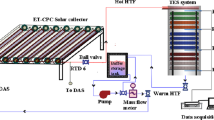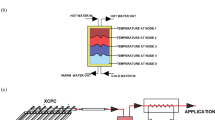Abstract
In this paper, thermodynamic analysis of an integrated system with parabolic collector which produces a number of outputs, such as heating, cooling, hot water, and electricity, is investigated. This integrated system consists of four main subsystems: concentrating collector, energy storage, Rankine cycle, and double-effect absorption cooling and heating. The renewable energy-based system is operated in two modes, which are solar mode and storage mode. Exergy destruction ratios and rates, power or heat transfer rates, and energy and exergy efficiencies of the system components and whole system are carried out. From the results, energy and exergy efficiencies for solar mode are found as 51.32 and 46.75 %, whereas for storage mode these efficiencies are calculated as 47.44 % and 45.43 %, respectively. Additionally, parametric studies, including the thermodynamic performance of the system and its components, are conducted by the change in some design parameters, as variation of the ambient temperature changes from 0 to 30 °C.
Access this chapter
Tax calculation will be finalised at checkout
Purchases are for personal use only
Similar content being viewed by others
Abbreviations
- E:
-
Energy, kJ
- Ė :
-
Energy rate, kW
- ex:
-
Specific exergy, kJ/kg
- Ėx :
-
Exergy rate, kW
- h:
-
Specific enthalpy, kJ/kg
- ṁ :
-
Mass flow rate, kg/s
- P:
-
Pressure, kPa
- \( \dot{Q} \) :
-
Heat rate, kW
- s:
-
Specific entropy, kJ/kgK
- T:
-
Temperature, K
- Ẇ :
-
Work transfer rate, kW
- η:
-
Energy efficiency
- ψ:
-
Exergy efficiency
- D:
-
Destruction
- in:
-
Inlet
- o:
-
Reference state
- out:
-
Outlet
- HEX:
-
Heat exchanger
- PDC:
-
Parabolic dish collector
- PTSC:
-
Parabolic trough solar collector
References
Ozturk M, Dincer I (2013) Thermodynamic assessment of an integrated solar power tower and coal gasification system for multi-generation purposes. Energy Conversion Manage 76:1061–1072
Dincer I, Zamfirescu C (2012) Renewable-energy-based multigeneration systems. Special issue on developments in nuclear and renewable energy. Int J Energy Res 36(15):1403–1415
Ahmadi P, Rosen MA, Dicer I (2011) Greenhouse gas emission and exergo-environmental analyses of trigeneration energy system. Int J Greenhouse Gas Control 5(6):1540–1549
Malico I, Carvalhinho AP, Tenreiro J (2009) Design of a trigeneration system using a high-temperature fuel cell. Int J Energy Res 33(2):144–151
Al-Sulaiman FA, Dincer I, Hamdullahpur F (2011) Exergy modeling of a new solar driven trigeneration system. Solar Energy 85(9):2228–2243
Al-Sulaiman FA, Hamdullahpur F, Dincer I (2011) Trigeneration: A comprehensive review based on prime movers. Int J Energy Res 35(3):233–258
Minciuc E, Corre OL, Athanasovici V, Tazerout M, Bitir I (2003) Thermodynamic analysis of trigeneration with absorption chilling machine. Appl Thermal Eng 23(5):1391–1404
Farshi LG, Mahmoudi SM, Rosen MA (2011) Analysis of crystallization risk in double effect absorption refrigeration systems. Appl Thermal Eng 31(10):1712–1717
Farshi LG, Mahmoudi SM, Rosen MA (2013) Exergoeconomic comparison of double effect and combined ejector-double effect absorption refrigeration systems. Appl Energy 103:700–711
Ozturk M, Dincer I (2013) Thermodynamic analysis of a solar-based multi-generation system with hydrogen production. Appl Thermal Eng 51(1–2):1235–1244
Buck R, Friedmann S (2007) Solar-assisted small solar tower trigeneration systems. J Solar Energy Eng 129(4):349–354
Dincer I, Rosen MA (2013) Exergy: energy, environment, and sustainable development, 2nd edn. Elsevier, Oxford
Klein SA (2007) Engineering Equation Solver (EES). Academic commercial, F-Chart Software, www.fChart.com
Petela R (2005) Exergy analysis of the solar cylindrical parabolic cooker. Solar Energy 79(3):221–233
Author information
Authors and Affiliations
Corresponding author
Editor information
Editors and Affiliations
Rights and permissions
Copyright information
© 2015 Springer International Publishing Switzerland
About this chapter
Cite this chapter
Cevrimli, U., Yuksel, Y.E., Ozturk, M. (2015). Thermodynamic Evaluation of an Integrated System with Concentrating Collector. In: Dincer, I., Colpan, C., Kizilkan, O., Ezan, M. (eds) Progress in Clean Energy, Volume 1. Springer, Cham. https://doi.org/10.1007/978-3-319-16709-1_5
Download citation
DOI: https://doi.org/10.1007/978-3-319-16709-1_5
Publisher Name: Springer, Cham
Print ISBN: 978-3-319-16708-4
Online ISBN: 978-3-319-16709-1
eBook Packages: EnergyEnergy (R0)




